Bro. Adam Bee Hive Feeder
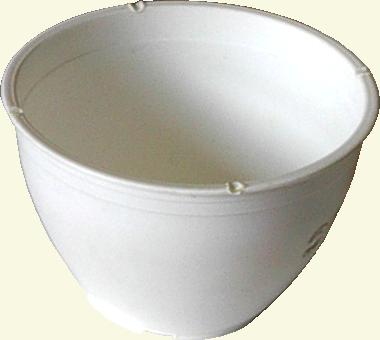
Simple to make this feeder is 460 mm square externally, has a central feeding station within a wooden tank that contains the feed. This version uses inexpensive plastic pudding basins in order to limit the bee's access to the bulk of the liquid.
One early problem that I found in my prototypes was that as soon as the bees started taking syrup, the rim of the bowl was forced firmly into contact with the plywood base of the trough. This caused the rim to become sealed by
suction and thus the bees took what they could, but the tank itself remained full. This was overcome by touching the rim in four places with a hot soldering iron which raised a small ridge of plastic either side of a shallow depression. This allowed a flow to occur.
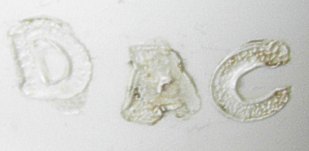
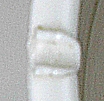
The two small pictures at right show a close up of the rim and also an inset of my
personal brand (applied at a lower temperature than for wood). Even at the lower temperature this branding was difficult as the curved surface allowed the branding iron to skid on the surface, causing the smeared appearance.
The rim modification allows syrup to leak through even if the raised ridges are broken off due to wear and tear.
The view below shows the layout without the pudding basin in place,
the dimensions and angles of the wooden cone (more of a truncated pyramid (frustrum), but
has always been called a 'cone') were chosen to fit the interior of the pudding
basin, leaving adequate space for bees to feed, but little exposed surface for drowning to occur.
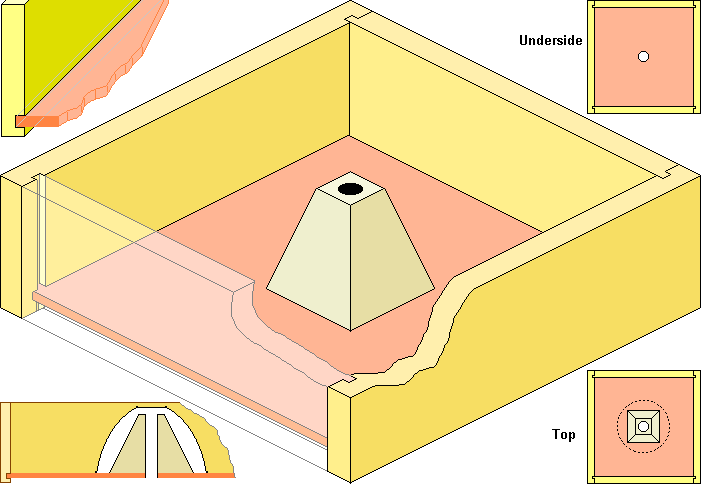
My prototype batch was of ten and due to availability of some chunks of timber the cones were made with the grain running vertically. The angled cuts were made using a band saw which left a surface that was fibrous without being rough. Such a surface was deemed to be an advantage to the bees as it gave plenty of grip for the bees to regain dry land on the occasions that bees entered the syrup.
As this prototype batch was successful I cut all the remaining chunks of timber (several hundreds) and placed them on the shelf... This batch lasted for several years as the demand was fairly low for this item. So it was not until the late 1980s that I made another batch and as luck would have it I had about a hundred metres of suitably sized timber which had been recovered from the skids of the packing cases that a batch of textile machines had been delivered in. Owing to the length of these pieces it was sensible to profile the whole length of each piece and then use an overhand saw to form the individual blocks. This resulted in the grain running horizontally through the pyramidal shape, but as the surface finish was similar to the original it was thought that this would ke
no difference. Imagine my embarrassment when a friend of mine who had purchased a couple of these feeders reported that the cones were too tall for the bees to climb over the top of... Upon quickly measuring a dozen or so at random off the shelves there were none that were not precisely the right size.
As an experiment I took a finished feeder off the shelf and filled it with water, the cone expanded by several millimetres, reducing the gap between the top of the cone and the underside of the pudding basin. However upon the
swollen cones drying out there was no (or very little) shrinkage. I had not realised that the textile machines were several tons in weight and the constant pressure over a period of about nine months had caused abnormal shrinkage as the timber dried out.
It is surprising how long it takes to soak 1,300 or so wooden blocks, dry them and re-cut them, as well as wetting all of the finished stock and paring the excess off with a chisel.
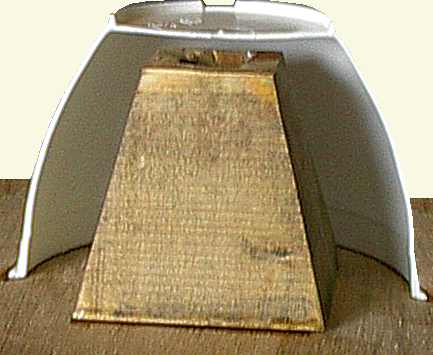
I have a reputation for gadgetry and thus from time to time I give lectures on gadgets. One demonstration item that I use is a cone glued down to a piece of plywood with half of a pudding basin cemented in place in the same
relationship as occurs in normal use. The photograph at right shows this demonstration piece.
The pudding basin was a stock item in Wilkinson's hardware shops and has the identification mark 1 1/2 lb on it's base.
The 'cone' has dimensions... base 82 mm square, 79 mm tall, top surface 43 mm square and the central hole is 25 mm diameter. In the photo at right the grain is horizontal and the vertical lines are witness marks from the band sawing operation.




